Kare11
Squash, Caramelized Onion and Gruyere Tart from Farm at the Arb

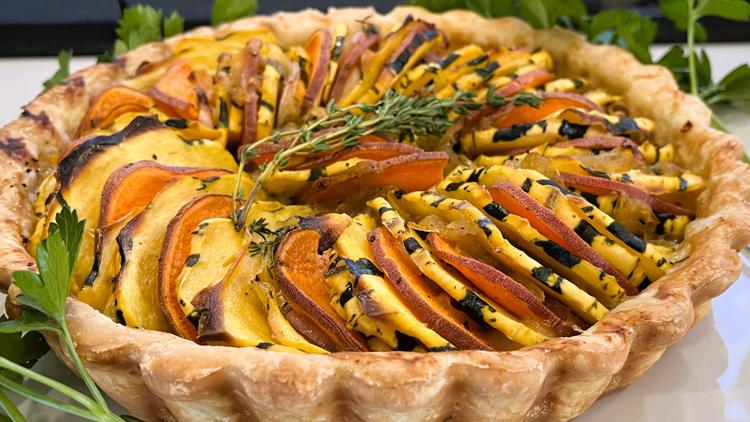
Chef Shelagh Mullen from the Arboretum’s culinary program whipped up this seasonably wholesome dish for the KARE 11 Saturday Holiday Cooking Show.
CHASKA, Minn — Food is usually best when it goes right from the farm to the kitchen.
And that’s exactly what happens at the U of M’s Minnesota Landscape Arboretum. Chef Shelagh Mullen is at the helm of the Farm at the Arb program, where they plant, grow and harvest produce and herbs and then create seasonably wholesome fare.
Chef Shelagh invited the KARE 11 Saturday crew into her kitchen to whip up a Carmelized Onion and Gruyere Tart, perfect for Thanksgiving and the entire holiday season.
Squash, Caramelized Onion and Gruyere Tart
- 2½ cups all-purpose flour
- 2 teaspoons sugar
- 1 teaspoon kosher salt
- 1 cup unsalted butter, cold and cut into cubes
- ½ cup + 2 tablespoons ice water
- 4 tablespoons extra-virgin olive oil, divided
- 2 medium onions, very thinly sliced*
- Kosher salt
- 3 garlic cloves, thinly sliced
- 1 tablespoon Dijon mustard
- Pinch of cayenne pepper
- 4 oz. coarsely grated sharp cheddar or Gruyère
- 2 delicata squash (about 1½ lbs), halved lengthwise, seeds removed, very thinly sliced* (half moons)
- 1 small sweet potato, very thinly sliced* (half moons)
- 1 small red onion or shallot, very thinly sliced*
- 2 sprigs fresh thyme, leaves removed
- 2 tablespoons unsalted butter
- Flaky sea salt
- An 11″- or 12″-diameter fluted tart pan with removable bottom
- Mandoline or food processor (or a very sharp knife)
Place a rack in the lower third of the oven; preheat to 375°.
FILLING: Swirl 2 tablespoons of oil in a large skillet to coat bottom and add the onions; season with kosher salt. Set the skillet over medium heat and cook onions, stirring occasionally and making sure to scrape the bottom of the pan, until very soft and deep golden brown, 20-30 minutes. Add garlic and cook, stirring occasionally, until onions are caramelized and deeply browned, 5-10 more minutes (if onions get super dark and stick to the pan, a few drops of water should dislodge them). Let cool.
CRUST: Place the flour, sugar, and salt in the bowl of a food processor, fitted with the metal blade. Add the cubed cold butter and pulse a few times, until the butter is evenly mixed in and resembles peas. Slowly add the water and pulse until the dough becomes crumbly and starts to stick together. Remove the dough from the food processor and put onto a clean surface. Form the dough into a ball and cover with plastic wrap. Chill the dough for at least 2 hours in the refrigerator.
Roll out dough on a lightly floured surface to about ⅛” thick. Transfer to tart pan. Lift up the edges and allow the dough to slump down into pan, don’t stretch the dough. Gently press into corners and trim excess. Freeze until firm, 15–20 minutes, or cover and chill in the fridge for up to 12 hours.
Cut sweet potato and red onion in half lengthwise, then thinly slice crosswise with mandoline or food processor. Drizzle remaining 2 tablespoons of oil over vegetables and season with kosher salt.
Brush mustard over chilled dough, then sprinkle with cayenne (from up high, but more even distribution). Layer in the cheese, then top with the caramelized onions in an even layer.
Arrange vegetables (alternating the squash, sweet potato and red onion) in concentric circles, with rounded edges facing up, starting from the outside edge, leaning slices against the crust, and working your way inward.
Loosely cover with foil and bake tart until edges of vegetables are browned (a few spots may even get deeply browned) and crust is golden brown, 60–75 minutes. Melt thyme and butter in a small saucepan and cook just until butter is bubbling. Baste the tart with the butter and thyme mixture a few times while it bakes. Sprinkle with crunchy salt, place back in the oven, uncovered for 10-15 minutes until the crust is golden brown and veggies are soft.
*Use a mandoline, a very sharp knife, or food processor, to thinly slice squash, sweet potatoes and onions.
Kare11
Cooks | Bellecour serves up suggestions for the perfect gravy

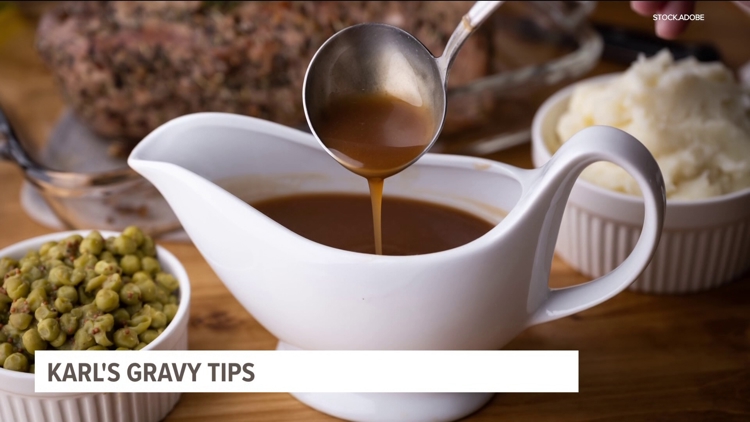
You can tell by the quote above that Cooks|Bellecour co-owner Karl Benson does not take the responsibility of making gravy lightly. Here’s his time-tested recipe.
GOLDEN VALLEY, Minn. — It is pretty clear that Cooks | Bellecour co-owner Karl Benson does not undervalue the sides and accouterments that may not bask in the spotlight but can make or break the holiday experience.
For example, Benson calls gravy “the sauce that ties the whole (Thanksgiving) meal together.” Whether it’s topping the mashed potatoes, elevating the stuffing or adding a new dimension to a pile of turkey, a good batch of gravy can push you from zero to HERO.
Karl dropped by the KARE 11 Saturday Holiday Cooking Show for a demonstration. Take a run at this recipe to see if it’s what the doctor ordered.
Karl Benson’s Gravy
- ¼ cup turkey fat and drippings
- ½ cup all-purpose flour
- ½ cup white wine
- 4 cups of homemade turkey stock (see note)
- 5 leaves fresh sage
- 3 sprigs thyme
- 1 sprig rosemary
- Salt and pepper to taste
- 1/4 cup of whipping cream for a creamy version
- 2 tablespoons apple cider for a nuanced fall flavor
- zest of an orange for a citrus undertone
- If using the drippings after roasting a turkey, remove the turkey and place onto a resting rack or cutting board, leaving the drippings and fat in the bottom of the pan.
- If making ahead of time, use the drippings and bits from roasting the turkey bones for stock.
- In a medium saucepan or the roasting pan itself, heat fat and drippings on medium heat until simmering. While whisking constantly, sprinkle the flour over the whole bottom of the pan, making sure to scrape up anything stuck to the bottom of the pan while whisking out any flour clumps.
- Continue to cook, over medium, whisking constantly, until the flour mixture gets thicker, homogenous, and lightly browned.
- Add the white wine and continue whisking until the flour has absorbed all of the liquid.
- Begin slowly adding the stock, still stirring constantly, approximately ½ cup at a time, to make sure the mixture stays smooth. Once all of the stock has been added, add the herbs and reduce to low so it can simmer until fragrant and thick. Optionally, finish with a small amount of cream.
- Serve warm.
Kare11
RECIPE: Thanksgiving Turkey Roulade | kare11.com
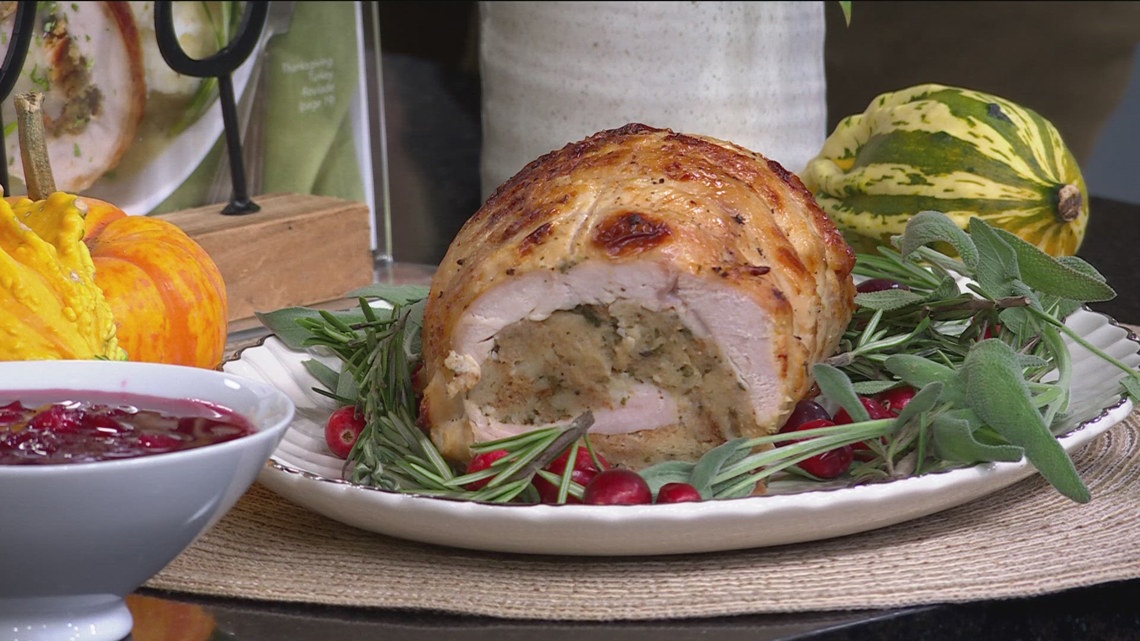
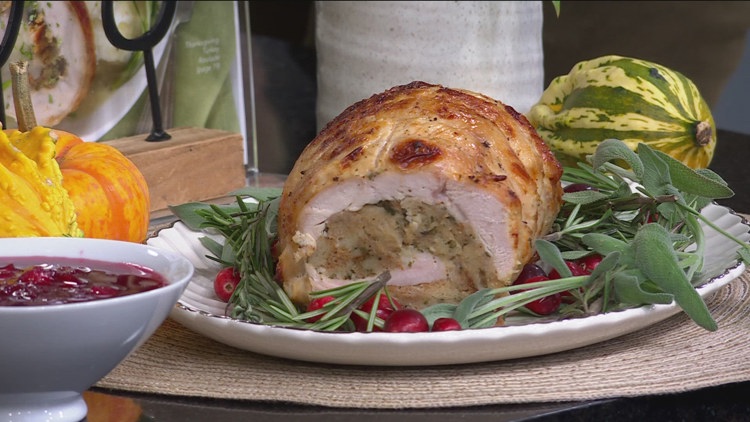
Kowalski’s Culinary & Branding Director, Rachael Perron, is back at KARE 11 Saturday for the annual Thanksgiving Show to deliver a tasty dish.
GOLDEN VALLEY, Minn. — How does this sound for your Thanksgiving dinner? A boneless breast is wrapped around stuffing and rolled into a perfectly sliceable “roast” that offers the ideal stuffing-to-turkey ratio. Perfect for impressing guests, this recipe cooks faster and is easier to serve than a whole bird while still delivering a classic Thanksgiving taste in every bite.
Kowalski’s Culinary & Branding Director, Rachael Perron, is back at KARE 11 Saturday for the annual Thanksgiving Show to deliver a tasty dish.
RECIPE: Thanksgiving Turkey Roulade
- 2-3 lb. split turkey breast, deboned, butterflied and pounded to an even ¼-½” thickness (see Tasty Tip)
- kosher salt and freshly ground Kowalski’s Black Peppercorns, to taste
- 3 cups (approx.) Kowalski’s Sausage & Sage or Wild Rice & Mushroom Stuffing (from the Deli Department)
- kitchen twine
- ¼ cup (½ stick) Kowalski’s Unsalted Butter, melted
- 2 cups chicken broth
- Kowalski’s Mashed Potatoes and Kowalski’s Poultry Gravy (from the Deli Department), warmed, for serving
- chopped fresh herbs (such as rosemary, thyme and/or sage), to taste
- Preheat oven to 375°.
- Lay flattened turkey skin-side down on a cutting board, short end facing you; season liberally with salt and pepper.
- Evenly spread stuffing on turkey breast, leaving a little more than a ½” border. Starting at the end closest to you, tightly roll the turkey around the stuffing, tucking in the ends to contain the filling. Tightly tie roulade with twine 1-2 times down the length of the roll, then across the width at 1″ intervals.
- Transfer roulade to a roasting rack set in a roasting pan. Brush with about ½ of the melted butter; season liberally with salt and pepper. Pour broth into the bottom of the pan.
- Roast roulade until internal temperature reaches 150° (50-60 min.), brushing with remaining butter about halfway through; increase temperature to 400° in the last 10 min. to crisp and darken the skin, if desired.
- Remove roulade from oven; let rest on the rack for 15 min. (internal temperature will increase to 165° during this rest period).
- Remove twine; slice roulade crosswise into ½” slices.
- Serve over mashed potatoes; drizzle with gravy and garnish with herbs.
Ask one of our butchers to debone and butterfly your turkey breast* or do it yourself, like so:
Remove the bone from the turkey breast. Lay the turkey breast flat on a cutting board, skin side down, with the shortest side facing you. Keeping a knife parallel to the board, use short strokes to carefully slice the breast in half horizontally, stopping about ¾” before reaching the left side. Open the turkey breast like a book. To flatten, cover it with plastic wrap; starting in the center, use a rolling pin or meat mallet to pound the breast to an even ¼-½” thickness, being careful not to rip through the turkey.
* Please allow 24 hrs. notice during busy periods.
Kare11
Viewers’ Thanksgiving questions answered by an expert
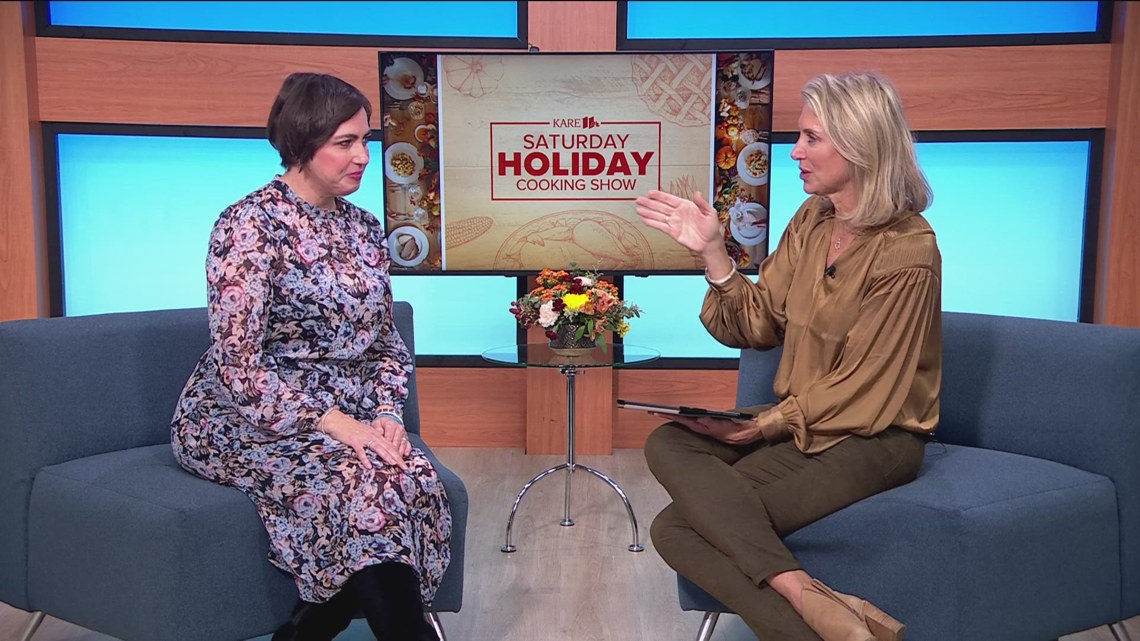
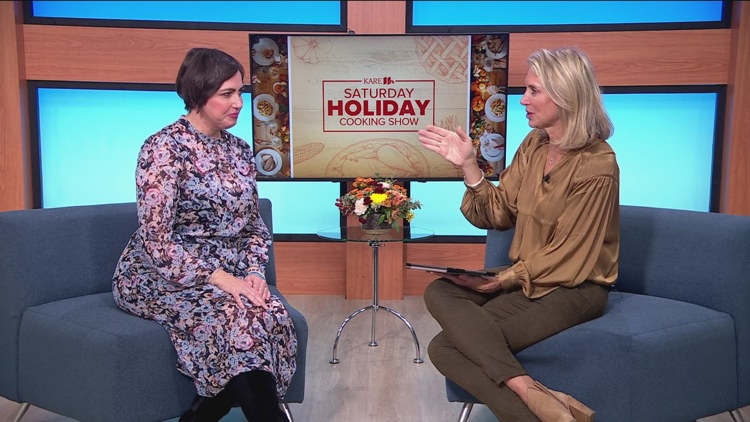
Kowalski’s Culinary & Branding Director, Rachael Perron, is back at KARE 11 Saturday offering cooking advice.
GOLDEN VALLEY, Minn. — Kowalski’s Culinary & Branding Director, Rachael Perron, is back at KARE 11 Saturday for the annual Thanksgiving Show to share a recipe and offer advice.
KARE 11 collected questions from viewers over a few weeks and Rachael gave her answers on the show:
Courtney from Chaska: I always cook my turkey breast up. But I’ve heard that cooking it breast down makes it more moist. What is your opinion?
The theory behind cooking a turkey breast side-down is that the connective tissues prevalent in the dark meat will drip down and continuously baste the white meat. However, you miss out on a golden, crisp skin, so if you like to have a showpiece/carve at the table, this isn’t for you.
Furthermore, the reason people are looking for ways to keep the white meat moist is because the white and dark meat cook at different rates so by the time your dark meat is done, the white meat is almost always overcooked.
A better practice, if you don’t mind missing out on the showpiece/whole bird, is to cut the turkey into parts and put the dark meat in ahead of the white.
Unnamed viewer: My son wants to smoke his turkey on the grill so I won’t have any drippings to make gravy. How can I still have homemade gravy??
The fat from the turkey is useful in making gravy, but it’s just one of a few ways the flavor in gravy is built. You can use another fat – I suggest butter for flavor and richness – in place of the drippings.
Build flavor in by sauteeing aromatics like onion or mushrooms in the fat, to add depth of flavor. (You can strain them out later if you don’t want them in the finished gravy).
Cook the fat-flour (roux) until it develops a good color and use a flavorful stock or broth.
Herbs and/or poultry seasoning (a personal favorite) are great flavor boosters, too.
Belinda in Edina: Should you use flour or baking powder in your gravy? What are the differences?
There is some thickener in commercial baking powder as a buffer but not enough for it to work well in gravy. It will also add a very unpleasant taste.
If you want to use a gluten-free alternative to flour you can use cornstarch instead. You need less cornstarch than flour for the same thickening effect. Cornstarch-thickened flour has the added benefit of being more glossy and not as opaque as flour-thickened gravy. Some think flour is better for flavor because of the protein in it – it browns nicely in the roux and, as we know, color = flavor.
Brian in New Hope: Every year we cut our turkey up into pieces and cook it on 2 baking sheets- it takes half the time and all the skin gets nice and crispy.
But, we also put butter underneath the skin, and when it melts, it drips onto the sheet pan, eventually burns and smokes up the kitchen.
Is there something else we can do to keep the meat from drying out and still get that crispy skin? Or a different method to prevent butter from burning up?
I love this method for cooking turkey parts!! I also love butter for crisping the skin and adding great flavor and color.
If you can put a rack in the bottom of your pan you can add a shallow pool of broth under it. That not only creates a steamy, moist environ for the meat, it has the added benefit of keeping the butter off the bottom of the pan. (I do this on the roulade I am cooking on the show Saturday!)
Otherwise, the best suggestion is to line the pan well with foil.
Unnamed viewer: Please help us establish what prep (specific details) we can do before the big Turkey Day so we can have a great meal but with a more relaxed approach for those preparing this quintessential meal! BTW I have been preparing this meal over 30 years Many Thanks…
I am a big believer in lists/timetables! Pies can be made days in advance.
“Casseroles” like dressing stuffing, green beans, sweet potatoes, corn, mac & cheese can be prepared a day ahead and baked the day of (stuffing is even better this way!) Make them as if you were putting them in the oven but instead wrap them and refrigerate until ready to bake.
Cranberry sauce and gravy can be made ahead.
It’s almost easier to say what I wouldn’t make ahead – the list is much shorter – turkey and mashed potatoes. Technically potatoes can be made ahead, but I personally think they are fluffier or creamier when whipped or mashed right before the meal.
Also, something people don’t often think about is to set the table or buffet the night before and pull serving pieces and utensils. This is a huge stress reliever and so many people leave it until the very last minute!




